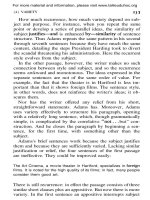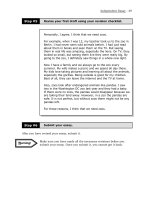Tài liệu Guide for writing technical reports pdf
Bạn đang xem bản rút gọn của tài liệu. Xem và tải ngay bản đầy đủ của tài liệu tại đây (265.81 KB, 18 trang )
Guide for writing technical reports
Swiss Federal Institute of Technology Lausanne
EPFL-DMT-IMS, 2001
Guide for writing technical reports
Guide for writing technical reports
Guide for writing technical reports
1
Preface
Report writing is one of the many things with which EPFL students are confronted.
You may have the feeling that this is a nuisance; however, reports are of great
importance for engineers.
The purpose of this guide is to help you, the student, with writing good reports.
While remaining compact, it combines basic advices and rules for lab experiment (TP),
semester and diploma reports. We emphasise that these are only guidelines. As a
consequence these rules should be applied with intelligence.
This is a modified copy of a manual that was made 20 years ago by teachers in Holland,
with a few additions from other sources. It has been adapted, we hope, to the tastes and
opinions of the teachers here.
Suggestions for improvements, from teachers and students, are welcome.
Harald van Lintel
Raphael Holzer
Pierre-André Besse
Lausanne, March 2001
v.1.1, 7/03/01 HvL
Guide for writing technical reports
2
Table of contents
1 THE AIMS OF A REPORT 3
2 STRUCTURING A REPORT 4
2.1 Laboratory reports (TP) 4
2.2 Semester and diploma reports 6
3 LAYOUT OF A REPORT 9
3.1 Basic layout 9
3.2 Numbering 9
3.3 Tables 10
3.4 Graphs 11
3.5 Number presentation 12
3.6 Literature list and citations 13
4 LANGUAGE ASPECTS 14
4.1 Concise and simple sentences 14
4.2 Short words and active verbs 14
5 HOW TO GO ABOUT WRITING A REPORT 15
5.1 The basis 15
5.2 Realisation 15
Guide for writing technical reports
3
1 The aims of a report
The purpose of a report is to transmit coherent information on a subject to the target
readers.
Reports at the EPFL are usually technical and should be based on verifiable facts or
experiments.
You should write the report in such a way that it will be as easy as possible for the
reader to understand, and eventually to apply the information in it. It is not a history of
your work.
Obviously, the requirements of your readers (and tutors especially) must be taken into
account: what information is requested, how much does the reader know already, what
interests him/her?
Your report should be written in such a way that your fellow students will be able to
understand it.
• In a laboratory (TP) report you must show that you are able to put order and
coherence in your measurement results, that you have insight in the accuracy
and reliability of the measurements and that you are able to link the experiment
to the related theory.
• Semester and diploma reports often are part of a project. The success of the
project may be influenced by the quality of the report. A clear and critical
problem description and a well-motivated solution form an important
contribution to the goal to be reached. Often a report is the starting point for a
next phase in the project. Therefore, a thorough description of the experiments
and results are important, as well as clearly formulated conclusions.
The teacher or tutor who has to judge the report will certainly appreciate it when the
contents are clearly the intellectual property of the writers. Copying someone else’s
work is not appreciated!
Guide for writing technical reports
4
2 Structuring a report
2.1 Laboratory reports (TP)
In general, depending on the type of experiment, for your “Travaille Pratique” report
you may use something like this:
• Title
• Purpose of the experiment
• Theoretical background
• Description of the experiment
• Results of the experiment
• Calculations
• Discussion of results
• Literature
• (List of symbols)
• Appendices (may be put ahead of “Literature”)
Answers to questions in the TP instruction are to be integrated in the report in the
appropriate places.
Hereunder follow some clarifications and details in relation to the above example
layout.
2.1.1 Title
Every report must be clearly recognizable by its title. The title is here a compact
description of the experiment.
This title appears on a title or cover page, that also should contain the following
information:
• Names of the authors
• Class, affiliation
• Date
2.1.2 Purpose of the experiment
Describe in detail the purpose of the experiment and try to touch the heart of the matter.
2.1.3 Theoretical background
Explain shortly the background, preferably using consulted literature. You should
include short derivations of non-standard formulas in the main text.
2.1.4 Description of the experiment
Here the experiment or practical training is described. You should include things as:
• Description of the measurement equipment









